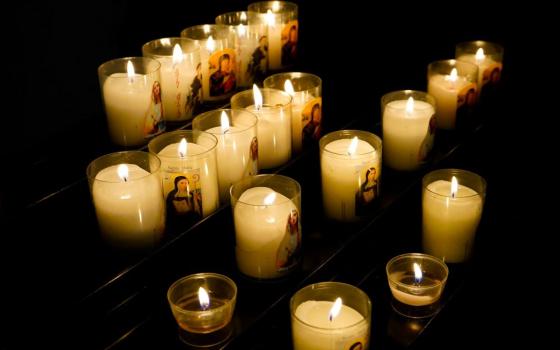
A tapestry showing 12th-century German abbess St. Hildegard of Bingen hangs from the facade of St. Peter's Basilica prior to the opening Mass of the Synod of Bishops for the new evangelization in St. Peter's Square Oct. 7, 2012, at the Vatican. (CNS/Paul Haring)
St. Hildegard of Bingen was a German mystic, visionary, prophetess, Benedictine abbess, and consecrated virgin in the 12th century. Recognizing her holiness of life as well as originality of works, Pope Benedict XVI proclaimed her a doctor of the church on Oct. 7, 2012. Surrounded by damp green forests of the Rhineland, this amazing woman was inspired to see God's "living power of light" in all creation and named it viriditas (in Latin).
When I was doing doctoral research on spiritual guidance and formation according to her mystical theology of viriditas, I could see the influence of this medieval theme on spiritual masters like Sts. Francis of Assisi, Ignatius of Loyola, Francis de Sales, John of the Cross, and others in Europe who came after her. That's why, it struck me that her spirituality could enhance discernment methods currently in use by vocation directors and spiritual guides in religious institutes even though they have diverse charisms and spiritual backgrounds.
The prophetess was a well-known physician who was seen as progressive and much ahead of her times. The Rule of Saint Benedict and the consecration of virgins profoundly impacted her spirituality. Bishops, priests, nuns, monks and political leaders didn't hesitate to seek her guidance on matters of concern. She has left us several volumes of wisdom and insight into numerous topics like health care, liturgical music, drama on virtues, and gospel homilies. What was extraordinary about her theological compositions and spirituality of viriditas, to make them relevant for all times — and enabling her as an abbess to be astonishingly creative in her consecrated life and mission? How did she relate it to her ministry? How could it aid discernment in the vocation ministry today?
Viriditas as a key to discernment
St. Hildegard was deep and non-dualist in her perceptions. She had an "theandrocosmic" ecology of life implying dialogue between God, humanity and the cosmos. Like software shaping her vision, the motif of viriditas developed into a robust spirituality and infused her monastic ora et labora or "prayer and work" with vibrancy through and through. The concept was drawn from her meditations on Scripture and writings of the Fathers of the Church. Very difficult to translate into English, it could have several nuances, such as greenness, healing power, vitality, progressive thrust, fruitfulness of celibate chastity, evolution, new creation, freshness and desire for more in God's service.
The mystic seems to have penetrated the depths of viriditas according to her familiarity with the four senses of Scripture: literal, allegorical, moral, and mystical. Even if taken literally, viriditas can neither be reduced to the greenness of ecology nor is it a medieval term for chlorophyll. Instead, it's the feminine aspect of God as creator, denoting freshness, fertility and growth in the spiritual life. Moreover, St. Hildegard describes greenness as growth in monastic life, making it an exegesis of the Gospel. Let me share newer insights developed from my meditations of this word in Scripture to make it relevant for the present-day American context.
Even if taken literally, viriditas can neither be reduced to the greenness of ecology nor is it a medieval term for chlorophyll. Instead, it's the feminine aspect of God as creator, denoting freshness, fertility and growth in the spiritual life.
Life sap
Viriditas is the connecting sap between the macrocosmic power of God and the microcosm of humanity, evidence of the reign of God and the kin-dom in our lives. It brings healing and renewal not only in plants but also in human beings. When the creation and flow of viriditas is blocked, the consecrated person is like a tree without sap that becomes barren and arid. In the biblical Book of Genesis, humans are the first creation of God's green finger. Our greening life energy comes from the very breath of God (Genesis 2:4-7). However, after disruption of the divine-human relationship caused by the fall, humanity enters a state of ariditas. It's later re-created in Christ through the viriditas of the savior's blood on the cross and the greening power of the Holy Spirit in baptism.
Good and bad viriditas
Greenness is present in vegetal life with good as well as bad qualities. The biblical Book of Sirach explains how a weed or reed growing on a rock, without deep roots, can't have good branches (Sirach 40:12-17). Such reeds from the banks of a lake or river are the first to be pulled out and used as wicks for lamps. Hence, they could symbolize the presence of the evil spirit posing as an angel of light. Prosperity, vigorous flourishing, or newness could indicate either good or bad viriditas. This is also reminiscent of greenness, referred to by Jesus, in the parabolic wheat and weeds of the Gospel of Matthew (13:24-30) and how it should be dealt with.

(Pixabay/Dominik & Frederike Schneider)
Ariditas and viriditas
At the moral level, grave sin causes ariditas or separation from God (Isaiah 59:2). However, the moisture of tears of repentance and conversion transforms ariditas into viriditas and in that way helps the reformed sinner to lead a virtuous life (Jeremiah 31:9). Jesus Christ reconciles the person with his Abba (1 John 4:10), and the Spirit regenerates (Titus 3:5-6) and encourages him/her to go all-out to lead a holy life after the conversion.
Viriditas in the aged
Since viriditas also implies holistic health, one may perhaps wonder whether it lessens with aging, since the five senses of hearing, vision, smell, taste and touch do tend to diminish. However, the weakening of the senses aids seniors to transcend physical stimuli and improves their capacity to focus on God in prayer. This makes them wiser and more mature in the spiritual life, inspiring them to move from action to deeper contemplation and union with God. Through mortification and penance, monks and nuns seek to anticipate what happens naturally in old age, in order to grow in holiness. Nevertheless, as a Benedictine abbess, St. Hildegard advises discretio or moderation in ascetism, which is one more characteristic of her understanding of viriditas.
Advertisement
Mysticism
At the mystical level of interpretation, even if St. Hildegard begins with the mysticism of nature and its lush greenness, she doesn't stop there. She engages herself further in the mysticism of sound, particularly through liturgical music that uplifts the soul in mystical union with God and deeper bonding within the community. Like discordant music, she discerns ariditas whenever the relations between God, humanity and the cosmos are fragmented.
In a nutshell, the lens of viriditas could be beneficial in discernment and was used by St. Hildegard in her monastic life and ministries. This amazingly gifted spiritual leader applied it anywhere it looked helpful for her dear nuns to be more effective in pastoral care and bearing witness to Jesus Christ. Viriditas as greening life energy stood out as the essence of her consecrated living and interactions with people. It unified her wisdom in diverse fields. Nevertheless, my explanation for her deeply mystical theology is only a tip of the iceberg.
It's outside the scope of this column to delve into discernment in vocation ministry today. So, in a later column, I'll continue elaborating on the green finger of God in discernment by focusing on how it could serve the purpose for vocation directors at the communitarian or institutional levels in the United States.





